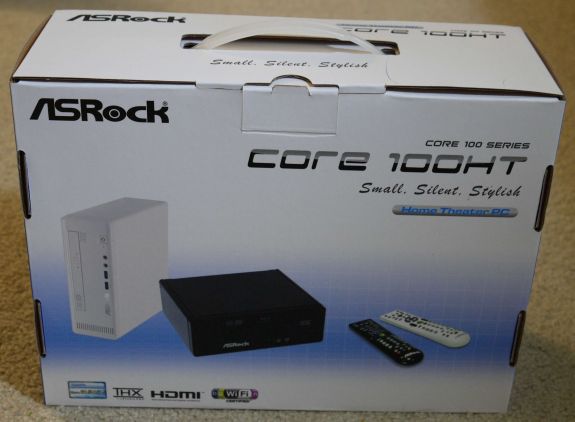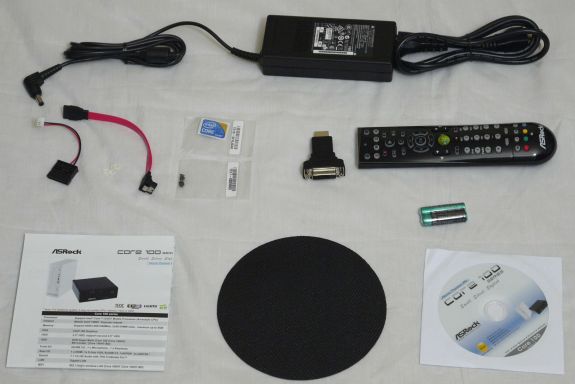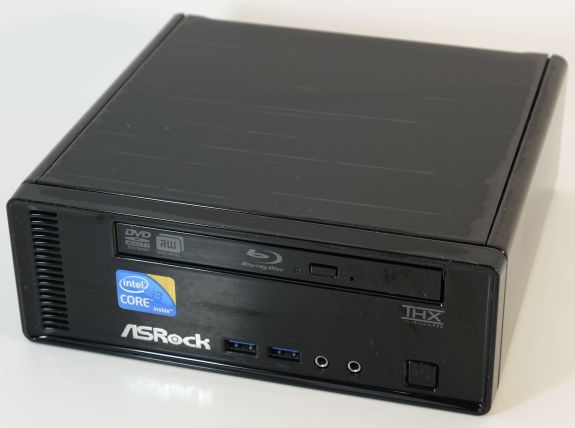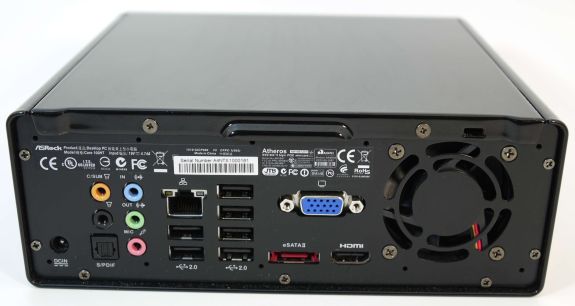ASRock Core 100HT-BD : Bringing HTPCs to the Mainstream Market [UPDATED : Noise Issue]
by Ganesh T S on July 19, 2010 9:34 PM EST- Posted in
- Home Theater
- Arrandale
- ASRock
- Media Streamer
- Core i3
- HTPC
The Core 100 HT-BD comes in a small package, and at first you wonder how such a powerful unit could come in such a small size.
Apart from the main unit, the package also bundles the following:
1. 90W AC / DC Adapter
2. SATA and power cables, as well as mounting screws for an optional second 2.5" hard disk
3. HDMI to DVI adapter
4. MCE remote and batteries.
5. Manual with instructions for disassembling and mounting the optional disk drive
6. Anti-slip pad for the base of the unit
7. CD with drivers and ASRock utilities
The appearance and dimensions of the unit are very similar to that of the ION 330-HT that was reviewed last August. The build quality of the chassis is top notch, and the unit will have no problem in blending with the A/V equipment of most consumers. However, the abrupt edges of the unit will not sit well with those interested more in the aesthetics and appearance rather than the internal capabilities of the unit. In the next iteration of the product, ASRock will probably work on the industrial design a bit more. Replacing the slimline Blu-Ray drive with a slot-loading type drive would also improve the appearance. These types of changes would enable them to cater to the segment of consumers who go more by the looks also.
We had mentioned in the ION 330 review about the absence of ports on the front panel being a bit strange, and ASRock has duly taken note, putting two USB 3.0 ports on the front panel. In addition, we also have headphone and microphone jacks in front. A set of vents on the left of the front panel helps in cooling the unit by maintaining air circulation. The slimline Blu-Ray drive is the same as those which make an appearance in various notebooks. The cost of such drives has come down drastically in the last 1 year, and we don't expect this component to add on too much cost over the DVD drive only version. Notably absent in the ION 330, but making an appearance in this unit is the THX logo above the power button to the right of the front panel.
ASRock uses the two sides of the unit as antennae for the Atheros WiFi module. Moving on to the rear of the unit, we find the adapter power input, followed by the audio ports. Analog audio output can be connected directly to the speakers, or the optical SPDIF output can be used to connect to older A/V receivers. Following this is the Gigabit Ethernet port, and 6 USB 2.0 slots. Further to the right, we have the VGA output (we really needed a DVI here), beneath which one gets the eSATA slot and HDMI output port. Wrapping up this panel is the ventilation fan. Our only gripe with the back panel is the placement of the eSATA port, which makes it difficult to connect external hard disks, particularly when the VGA port is being used.
Just like a notebook, this unit also supports simultaneous display on two monitors. Testing was done mostly with the HDMI output connected to a Toshiba REGZA 37" 1080p TV through an Onkyo TX-SR 606, and the VGA port connected to a old Dell monitor running at 1280x1024. It must be noted that the HDMI port on the unit is only 1.3a. This makes it impossible for the unit to drive monitors with resolutions higher than 1920x1080. Even extremely affordable 2048x1152 monitors such as this one from Dell are left unsupported at their maximum resolutions. However, we expect that this will not be a concern to buyers, since the unit will probably end up getting connected to a 1080p TV in most scenarios.
The Core 100 HT-BD ships with no OS installed. For the purpose of this review, we loaded up a copy of Windows 7 Ultimate x64. It is also possible to install Ubuntu or any other Linux distribution and still be able to take advantage of most of the HTPC functions of the system. Our analysis in the rest of the article, however, is completely from the Windows 7 standpoint.
Starting with this piece, all our media streamer and HTPC reviews will carry a table summarizing the data and A/V connectivity options for the unit from a home theater perspective. We will conclude this section with the same.
| Option | Status |
|---|---|
| HDMI | Yes [v1.3a] |
| Component | No |
| Composite | No |
| VGA | Yes |
| SPDIF | Yes [Optical] |
| Stereo | Yes |
| Option | Status |
|---|---|
| Optical Disk Drive | Yes [Blu-Ray] |
| USB | Yes [6 x v2.0, 2 x v3.0] |
| eSATA | Yes |
| LAN | Yes [ 1000 Mbps GbE ] |
| Internal HDD | Yes [ 500 GB ] |
| WiFi | Yes [ 300 Mbps 802.11n ] |
| Card Reader | No |














107 Comments
View All Comments
ganeshts - Tuesday, July 20, 2010 - link
erictorch,Thanks for informing me about eWiz carrying the mobile processor. We searched on the usual haunts (Amazon and Newegg), and neither of them carried the processor
I perused further, and it looks like the i3-330M is the only i series processor they have (The i7 mobile they carry has no GPU die in the package and its TDP is 45W).
In any case, I couldn't find a mobo based on the HM55. Are you aware of any with the PGA 988 socket?
By the way, I did see AHCI is selectable in the BIOS, but didn't personally verify whether it works. I will get back to you here in a couple of days if it doesn't :)
erictorch - Tuesday, July 20, 2010 - link
I stumbled upon this list of mini-itx motherboardshttp://www.silentpcreview.com/forums/viewtopic.php...
with froogle.com I was able to find the
IEI KINO-QM57A $320
IBASE MI953F $440
DFI CP100-NRM $400
I was also able to find the i5 mobile CPU through pricewatch.com
ganeshts - Tuesday, July 20, 2010 - link
Thanks for the links, erictorch.At $320 for the board, a build similar to the Core 100 is going to be pretty costly.. We had budgeted $140 for the board.
I wonder how many end users actually end up doing builds based on these mobos.
But you are right! It is possible to do such a build on one's own if the necessary efforts are taken. However, most people will go in for the Clarkdale builds because they are much more cost efficient.
spddemon - Wednesday, July 21, 2010 - link
That is very true, ganeshts; however, I would love to see what the end result would be with one of those boards instead of a clarkdale...I am more than willing to spend a couple hundred more for a true low powered system providing my performance and functionality were not hindered.
I was targeting a Core i3 530 but if the performance per watt of the 330 is close to the 530 then it could be a great trade off.
I will have to add this info to my build sheet and see where it goes.. I have sifted the hardware down quite a bit, but I still have a lot of products to research before i start..
Riccardo - Tuesday, July 20, 2010 - link
Hi Ganesh,Good work on this review - I really appreciate the HTPC focus on this one. I look forward to seeing it used again in relevant reviews. Thanks!
Pessimism - Tuesday, July 20, 2010 - link
I'd pay an extra $5 for a remote that doesn't look so cheesy and cheap. They aren't the only company at fault though. I see a LOT of slick looking devices with cheap, tacky, flimsy looking remotes that don't match up with the look of the device whatsoever.OblivionLord - Tuesday, July 20, 2010 - link
I'm thinking that people would be more inclined to believe your point of using a USB capture card if they knew the real benefit of it compared to a typical PCI Capture card. The only real physical drawback with the USB card is that you need a second one if you want a dual tuner setup.The other problem is that the quality of the captured video produced by a USB card is inferior to a PCI capture card. This is what I've come to believe since I've never owned a USB card for this purpose.
Perhaps you should do a comparison of a few USB capture devices vs PCI capture cards. This will show the truth.
pcfxer - Tuesday, July 20, 2010 - link
I'm surprised that you chose A-weighting for the measurement of the machine. I'm also surprised that you used the Radioshack and took the 53dB as a "solid" measurement. I have the same SPL meter and its accuracy does not live in the 50dB range. It is far more accurate and stable (if you've used this to get any meaningful information you'll know what I mean) 65+dB.That said, I am fully aware of the noise required to gain measurement on that darn thing. That "HTPC" is effing LOUD! Even inside my case I get the good old Lo A-weighted/C-weighted.
ganeshts - Tuesday, July 20, 2010 - link
pcfxer,Thanks for your feedback. I will keep this in mind for future reviews.
Shadowmaster625 - Tuesday, July 20, 2010 - link
Mainstream Market? For $700? I got news for you... there may be millions of mindless drones rushing out to buy iCrap, but this is way above and beyond mainstream for a HTPC. It only costs $100 to build a HTPC. Anything more than that and you may as well go on ebay and buy a notebook with a damaged LCD and use that as a HTPC (assuming it has hdmi out of course).